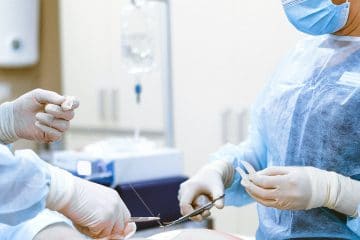What is the Function of the Pancreas? – Introduction
The pancreas is a glandular organ in the abdomen that regulates the endocrine and digestive systems. The pancreas can be divided into two: exocrine and endocrine. The exocrine pancreas secretes its product to the body surface through ducts within the organ, while the endocrine pancreas secretes directly into the bloodstream.
The Physiology of the Pancreas (Function)
To regulate the digestive system, the exocrine pancreas secretes enzymes that help digest the food that reaches the stomach using the pancreatic cells organized in acini.
The islets of Langerhans are the cells within the endocrine pancreas that secretes insulin, glucagon, somatostatin, and pancreatic polypeptides. Insulin and glucagon regulate the metabolism of carbohydrates, proteins, and fats. Somatostatin plays a role in the regulation of islet cell secretion, and the pancreatic polypeptide is probably concerned primarily with regulating ion transport in the intestine.
Insulin is anabolic, increasing the storage of glucose, fatty acids, and amino acids, and an excess causes hypoglycemia, which leads to convulsions and coma. Insulin deficiency, either absolute or relative, causes diabetes mellitus (chronically elevated blood glucose), a complex and debilitating disease that, if untreated, is eventually fatal.
Glucagon is catabolic, mobilizing glucose, fatty acids, and amino acids from stores into the bloodstream. Glucagon deficiency can cause hypoglycemia, and glucagon excess makes diabetes worse.
Somatostatin can cause hyperglycemia and other manifestations of diabetes when secreted in excess.
In this article, we will talk about the anatomy of the pancreas, its endocrine and exocrine functions, and the most common illnesses of the pancreas.
The Anatomy of the Pancreas
The pancreas is a posterior organ located in the abdominal cavity, below the liver and behind the stomach. It is surrounded by the duodenum, and In adult humans, the pancreas weighs 80 g. It is located in the middle part of the abdominal cavity, so it has several relationships with other organs, such as the stomach and the liver.
The pancreas is divided into four parts: the head, the neck, the body, and the tail. In the head is the exit of both the ducts of the pancreas and the duct of the gallbladder, which join there and release their secretions into the first portion of the small intestine (duodenum).
The pancreas is supplied by two major arteries, the celiac, and superior mesenteric arteries, and the venous drainage is via the splenic vein and the superior mesenteric vein. Both parasympathetic and sympathetic nervous systems innervate the pancreas.
Most of the pancreatic tissue is made up of the exocrine component (or exocrine pancreas), which contains various cells of serous pancreatic acini. These acini are capable of synthesizing and secreting a wide variety of essential enzymes so that the digestive process can be carried out successfully. The endocrine component (or endocrine pancreas) is a smaller portion of the pancreas compared to the exocrine pancreas, but equally important. It is made up of pancreatic islets, which appear to be islands of cells scattered among the pancreatic acini. Islet cells produce and secrete hormones that regulate glucose, lipid, and protein metabolism. (1)
Exocrine Pancreas
Secretory units: pancreatic acini.
Cells: Acinar cells.
Products: Peptidases, lipases, amylolytic enzymes, nucleolytic enzymes.
Endocrine Pancreas
Secretory units: Pancreatic islets (of Langerhans).
Cells: B (beta) cells, A (alpha) cells, D (delta) cells, PP (pancreatic polypeptide) cells.
Products: Insulin, glucagon, and somatostatin.
Pancreatic Exocrine Function
Reference: (2)
The digestive function of the pancreas consists of secreting ions and water by the exocrine pancreas. This is important to transport the digestive enzymes from the place they are produced in the pancreatic cells to the small intestine.
These combinations of water, ions, and enzymes are secreted into the ducts inside the pancreas and are merged with bile ducts at the head of the pancreas.
Also, the pancreatic secretion has a high pH (alkalotic) to contrast the acidity of the gastric acid produced by the stomach. A neutral pH in the intestine is important for the optimal function of the digestive enzymes. To make this secretion alkalotic, the pancreas produces bicarbonate by combining water with carbon dioxide.
The enzymes secreted by the pancreas are:
Proteases: They digest proteins. Chymotrypsinogen and Trypsinogen.
Pancreatic lipase: helps digest lipids (fat compounds).
Amylase: Digest carbohydrates.
Other enzymes: ribonuclease, gelatinase, elastase, etc.
Regulation of Pancreatic Secretions
One of the ways that the pancreas regulates its secretions is by receiving a stimulus like smelling or tasting food. When this happens, the nerves send a signal to the pancreas to start producing the enzymes.
Another way in which the body activates the pancreas is when the stomach acid, proteins, and fatty acids reach the small intestine.
A hormone named cholecystokinin, which leads to the secretion of bile in the gallbladder can also stimulate the pancreatic juices because of their relationship in the ducts on the head of the pancreas.
Pancreatic Endocrine Function
Reference: (3)
Insulin
Insulin is a polypeptide hormone synthesized in the B cells and packaged into granules that are released into the bloodstream. Insulin is first synthesized as a larger product called preprohormone and is processed into proinsulin before being divided into insulin and C peptide.
The physiologic effects of insulin include hypoglycemic effects, storage of carbohydrates, protein, and fat, stimulation of protein synthesis and growth, and inhibition of protein degradation. The circulating half-life of insulin is short.
Insulin is appropriately called the “hormone of abundance.” Failure to grow is a symptom of diabetes in children, and insulin stimulates growth in immature hypophysectomized rats to almost the same degree as growth hormone.
Glucagon
Glucagon is a hormone that increases glucose output from the liver and stimulates the fraction of lipids. It is degraded by many tissues, especially the liver, and has a half-life of 5-10 minutes.
Glucagon secretion is increased by hypoglycemia, sympathetic nerve stimulation, proteic meals, and exercise and is inhibited by a rise in glucose, somatostatin, free fatty acids, and ketones (a product of the breakdown of lipids) in the bloodstream.
Glucagon also stimulates the secretion of growth hormone, insulin, and pancreatic somatostatin and makes your heart muscles contractions stronger to increase the amount of blood the heart can pump out.
Somatostatin
Somatostatin inhibits the secretion of insulin, glucagon, and pancreatic polypeptide in the pancreas, acting locally in tissues nearby.
Somatostatin-secreting pancreatic tumors cause hyperglycemia and diabetes, dyspepsia, and gallstones.
The secretion of somatostatin is increased by glucose, amino acids, and CCK (an important hormonal regulator of the digestive process). It is released into the peripheral blood from both the pancreas and gastrointestinal tract.
Pancreatic Polypeptide
The secretion of this polypeptide is increased by meals that contain proteins, fasting, exercise, and fast descent of sugar in the bloodstream, and decreased by somatostatin and intravenous glucose. Its exact function is uncertain.
Most Common Diseases of the Pancreas
Reference: (4)
Inflammatory Diseases
Chronic and acute pancreatitis: This is a result of the enzymes produced for digestion in the pancreas activating before reaching the small intestine and therefore digesting the pancreas itself. The causes of this illness are varied. Chronic pancreatitis is the most common pancreatic disease, but it can also be acute.
Neoplastic Disease
Tumor or cysts: The most serious pancreatic disease is cancer because it is resistant to many common treatments, including chemotherapy and radiotherapy. Pancreatic cysts are a casual finding while doing a test for different reasons. The most common type of cysts are serous and are mostly benign.
Zollinger-Ellison Syndrome: This is a rare disorder where tumors grow in the abdominal organs that can cause many complications, including pain and stomach ulcers.
Hereditary Diseases
Cystic fibrosis: This is an inherited disease in which there is damage to the pancreatic ducts; as a consequence, pancreatic insufficiency occurs.
Diabetes: Diabetes is caused by the damage (Type 2 diabetes) or the failure (Type 1 diabetes) of the pancreatic cells that produce insulin, a hormone secreted by the pancreas to regulate the sugar in the blood (glucose). This dysfunction causes many complications and can be treated with dietary and lifestyle changes and medications or insulin injections.
Shwachman-Diamond syndrome: This is a rare hereditary disease that affects the exocrine function of the pancreas and can contribute to the development of blood cancer (leukemia or lymphoma).
Frequently Asked Questions About the Function of the Pancreas
How can I keep my pancreas healthy?
Maintain a healthy diet with the inclusion of fruits, vegetables, lean protein, and whole grains. Regular exercise, avoiding excessive alcohol consumption, avoiding smoking, processed foods, sugar, and unhealthy fats, and having a healthy weight, impacts significantly in the pancreas health and reduces the risk of developing a pancreatic disease.
How can pancreatic diseases be treated?
The treatment of pancreatic diseases depends on the condition and the severity of them. Some treatment options can include a healthy lifestyle change, medication to manage symptoms, or enzyme replacement therapy when the function of the pancreas is not sufficient. In severe cases or when we have a tumor, surgical intervention or chemotherapy and radiation therapy are an option. Treatment plans are adjusted to each individual person and are best determined by healthcare professionals specializing in pancreatic diseases.
Can we live without the pancreas?
Yes, it is possible to live without a pancreas, but for this, you will require chronic medical care because the functions of the pancreas would have to be replaced by medication and diet. Lifelong treatment for diabetes and enzyme replacement therapy to digest foods would be required.
Conclusions
The pancreas is a vital organ because of both exocrine and endocrine functions, aiding in digestion and playing a crucial role in breaking down proteins, lipids, and carbohydrates.
The endocrine component consists of the secretion of insulin, glucagon, and other hormones that promote the regulation of sugar in the bloodstream along with other functions.
The pancreas regulates its secretion through various stimuli, like the presence of food in the stomach and small intestine.
Understanding the anatomy and function of the pancreas is crucial to recognize and manage various pancreatic diseases. Some of these illnesses are inflammatory, for example, pancreatitis, and others are neoplastic or hereditary.
The pancreas plays a vital role in maintaining the balance of the body’s metabolic processes.
Further research in understanding and treating pancreatic diseases is essential for improving the quality of life for individuals affected by these conditions.
See Also
Can You Live Without a Pancreas?
What is Chronic Pancreatitis | Risk Factors | Complications | Treatment
List of Diseases Caused By Alcohol Abuse
Do Sugary Drinks Cause Cancer?
Gallbladder Surgery Recovery Time
Fat Transfer Breast Augmentation Surgery
References
- Marcell Laguna. Páncreas (histología). Last revision 18 de Mayo de 2023. KenHub. Available from: https://www.kenhub.com/es/library/anatomia-es/pancreas-histologia
- Pandol SJ. The Exocrine Pancreas. San Rafael (CA): Morgan & Claypool Life Sciences; 2010. Introduction. Available from: https://www.ncbi.nlm.nih.gov/books/NBK54131/
- Kim E. Barrett, Susan M. Barman, Scott Boitano, Heddwen L. Brooks. Ganong: Fisiologia medica. 24 edition. :Mc. Graw – Hills; 2013.
- Karpińska M, Czauderna M. Pancreas-Its Functions, Disorders, and Physiological Impact on the Mammals’ Organism. Front Physiol. 2022 Mar 30;13:807632. doi: 10.3389/fphys.2022.807632. PMID: 35431983; PMCID: PMC9005876. Pancreas-Its Functions, Disorders, and Physiological Impact on the Mammals’ Organism – PubMed (nih.gov)
- Kamashi Pandirajan. Exocrine Pancreas [Internet]. TeachMe Physiology; Last updated: 23rd April 2023. Available from: https://teachmephysiology.com/gastrointestinal-system/other/exocrine-pancreas/
Franco Cuevas is a physician who graduated from the National University of Córdoba, Argentina. He practices general medicine in the Emergency Department at Sanatorio de la Cañada, Córdoba. His focus is on writing medical content to improve physicians' access to relevant medical information for daily practice. He has participated in some research projects and has a special joy in teaching and writing about medical concepts.


